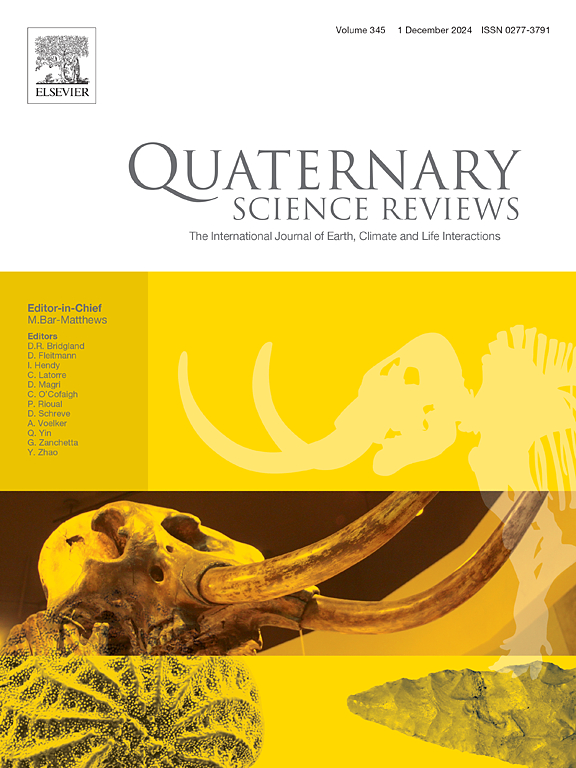Ice-burial history and early Holocene thinning of the Scandinavian Ice Sheet at Gaustatoppen, southern Norway
IF 3.2
1区 地球科学
Q1 GEOGRAPHY, PHYSICAL
引用次数: 0
Abstract
This paper explores the glacial history of Gaustatoppen Mountain in southern Norway using cosmogenic nuclide analysis (in situ 14C, 26Al, 10Be, 21Ne) from a vertical transect of surface samples and a shallow (1.3 m) bedrock profile. Analysis of in situ 14C is central to establishing that the entire mountain was buried by the Scandinavian Ice Sheet during the Last Glacial Maximum until rapid thinning (0.4–19 m yr−1) at the end of the Younger Dryas isochrone and/or in the Early Holocene. This implies that ice-sheet thinning coincided with rapid retreat from coastal moraines (c. 190 m yr−1) and suggests that the ice margin retreated faster inland than former ice-sheet reconstructions suggest. We further deduce that the Scandinavian Ice Sheet expanded to bury Gaustatoppen no later than c. 31–36 ka consistent with regional chronologies. Just below the summit, long-lived cosmogenic nuclide ages cluster at c. 70–80 ka, indicating a pre-Last Glacial Maximum erosional event possibly linked to the penultimate glacial maximum. Using Markov Chain Monte Carlo inversion modelling of cosmogenic 10Be and 26Al in a depth profile we constrain the most likely ice burial and erosion history. We find that Gaustatoppen (at 1714 m a.s.l.) was buried by ice for c. 1.3–26.3 % of time since 500 ka, and that the sampled bedrock outcrop eroded c. 2.6–11.8 m within the same period, and with the last 1 m of erosion occurring within the last c. 130–200 kyr. Collectively, these findings provide valuable insights into the dimensions and dynamics of the Scandinavian Ice Sheet during the last glacial period.
挪威南部Gaustatoppen斯堪的纳维亚冰盖的冰埋史和全新世早期减薄
本文利用宇宙成因核素分析(原位14C, 26Al, 10Be, 21Ne),从地表样品的垂直样带和浅层(1.3 m)基岩剖面探讨了挪威南部Gaustatoppen山的冰川历史。原位14C的分析对于确定整个山在末次盛冰期被斯堪的纳维亚冰盖掩埋,直到新仙女木期等时线结束和/或全新世早期迅速变薄(0.4-19 m yr - 1)至关重要。这表明冰盖变薄与沿海冰碛的快速退缩(约190 m yr - 1)同时发生,并表明冰缘向内陆的退缩速度比以前的冰盖重建所显示的要快。我们进一步推断,斯堪的纳维亚冰盖扩张埋葬Gaustatoppen不迟于c. 31-36 ka,与区域年代学一致。在峰顶下方,长寿命的宇宙核素年龄聚集在约70-80 ka,表明末次冰期极大期前的一次侵蚀事件可能与次冰期极大期有关。利用宇宙成因10Be和26Al的马尔科夫链蒙特卡罗反演模型,我们约束了最可能的冰埋藏和侵蚀历史。我们发现,自500 ka以来,Gaustatoppen (1714 m a.s.l)约有1.3 ~ 26.3%的时间被冰掩埋,基岩露头在同一时期内侵蚀了2.6 ~ 11.8 m,最后1 m的侵蚀发生在最近的c. 130 ~ 200 kyr。总的来说,这些发现为了解末次冰期斯堪的纳维亚冰盖的规模和动态提供了有价值的见解。
本文章由计算机程序翻译,如有差异,请以英文原文为准。
求助全文
约1分钟内获得全文
求助全文
来源期刊

Quaternary Science Reviews
地学-地球科学综合
CiteScore
7.50
自引率
15.00%
发文量
388
审稿时长
3 months
期刊介绍:
Quaternary Science Reviews caters for all aspects of Quaternary science, and includes, for example, geology, geomorphology, geography, archaeology, soil science, palaeobotany, palaeontology, palaeoclimatology and the full range of applicable dating methods. The dividing line between what constitutes the review paper and one which contains new original data is not easy to establish, so QSR also publishes papers with new data especially if these perform a review function. All the Quaternary sciences are changing rapidly and subject to re-evaluation as the pace of discovery quickens; thus the diverse but comprehensive role of Quaternary Science Reviews keeps readers abreast of the wider issues relating to new developments in the field.
 求助内容:
求助内容: 应助结果提醒方式:
应助结果提醒方式:


